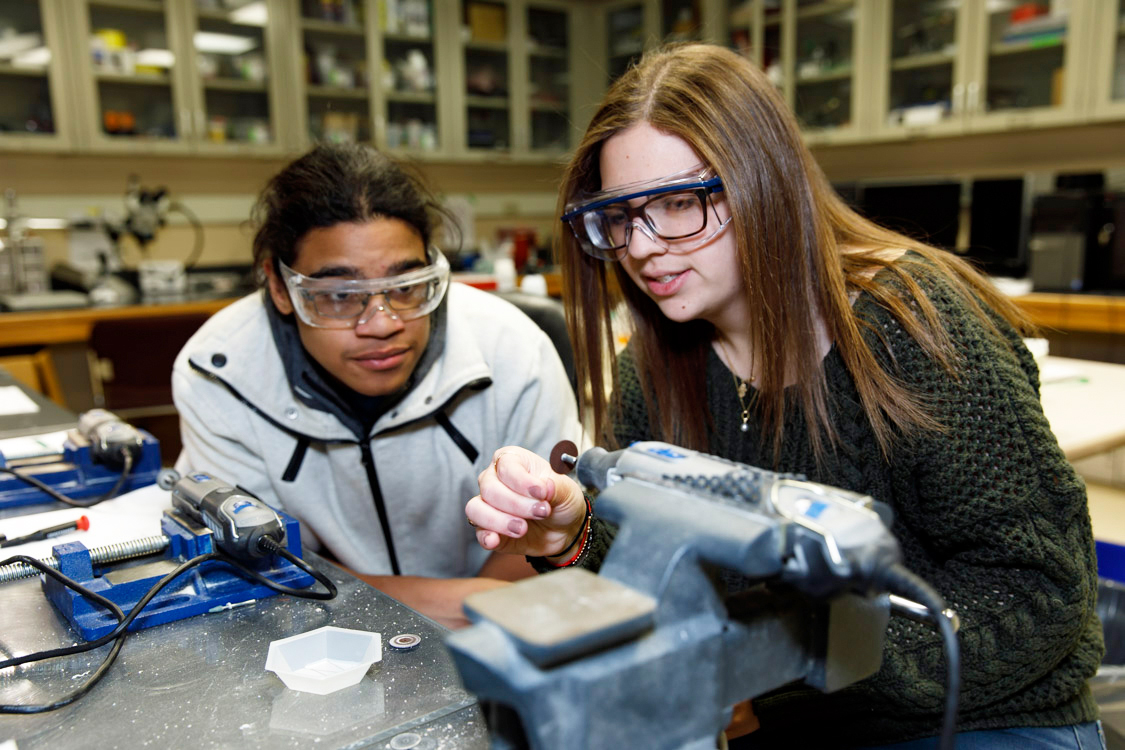Undergrads share lab know-how with high school students
By Kathy Hovis

In her lab in the basement of Uris Hall, Lindsay Rait ’17 experiments with rats as she studies the role of the brain’s hippocampus in contextual memory. One day a week, she welcomes Lehman Alternative Community School junior Mohammed Williams into the lab, where he soaks up information about her research methods and also explores whether a career in research might be right for him.
They are two of 20 pairs of Cornell students and high school students who work together as part of a new Young Researchers Program of the Cornell Undergraduate Research Board (CURB).
CURB already offers mentoring programs that pair upper-class Cornell students with younger students, so the extension to high school students seemed like a natural one, said Isabella Salas-Allende ’19, a biological sciences major and CURB’s outreach chair.
“In high school, I was fortunate to participate in Rockefeller University’s Summer Science Research Program and conduct hands-on research,” said Salas-Allende, who won the Robinson-Appel Humanitarian Award the spring of her freshman year, receiving $1,500 to pilot the Young Researchers project.
For Rait, a psychology major in the College of Arts and Sciences with minors in biometry and statistics and Jewish studies, working with a high school student is a way to give back.
“My high school had a program that connected me to a mentor,” Rait said, “and I ended up doing research on anxiety and depression at the North Shore Long Island Jewish Medical Center. That was probably the biggest reason I’m doing research in college.”
Rait is part of the Laboratory of Neurobiology of Learning and Memory, whose principal investigator is David M. Smith, associate professor of psychology. The lab studies learning and memory processes in rodents by recording the activity of individual neurons in their brains.
Rait has had the opportunity to train rats and collect and analyze behavioral data. Her experiments involve training her rat on an odor-discrimination task where rats use context to remember which odor is correct. She is exploring the role of the hippocampus and olfactory system in this memory process.
As Rait’s assistant, Williams has learned how to prepare brain samples for viewing under a microscope, how to cut and sand cannula that Rait uses in her experiments, and other details about the methods Rait uses to train her rat.
Williams isn’t sure what he wants to study in college but signed up for the young researchers’ program because, “I’m interested in anything that I don’t know about related to science,” he said.
Juliet Borden, a junior at Ithaca High School, has a clear idea of her college major – pre-med – so the program’s focus on research appealed to her.
“I wanted to learn more about research because it is the underlying process by which new medical knowledge is created,” said Borden, who is paired once a week with Sherwin Ng ’18, a biological sciences major in Arts and Sciences concentrating in molecular and cell biology.
“In lab, I learned cloning protocols and various assays [laboratory tests], such as gel electrophoresis,” she said. “This was very interesting because despite my limited experience with running experiments, it was really fascinating to see how they all tied into the overall project.”
Ng works in the lab of Ailong Ke, associate professor of molecular biology and genetics, which conducts structural biology research on clustered regularly interspaced short palindromic repeats (CRISPR)-Cas systems involved in gene editing.
“In science, I feel like it is difficult to know what you don’t know,” Ng said. “However, I saw mentoring and teaching as a way to expose any unknown gaps that I may have had in my own understanding regarding the subject.”
Ng plans to go on for an M.D./Ph.D. and specialize in cardiology. “Because of the promising role of CRISPR in potentially treating genetic disorders, I would like to further research the intersection between CRISPR and cardiovascular disease,” he said.
Though he didn’t have research experience outside his high school science labs before coming to Cornell, Ng said he realized how helpful that would have been.
“This program allows me to cultivate a love for scientific research in current high school students, with the hope that one day, they will also be mentoring the next generation of young scientists,” he said.
Kathy Hovis is a writer for the College of Arts and Sciences.
Media Contact
Get Cornell news delivered right to your inbox.
Subscribe